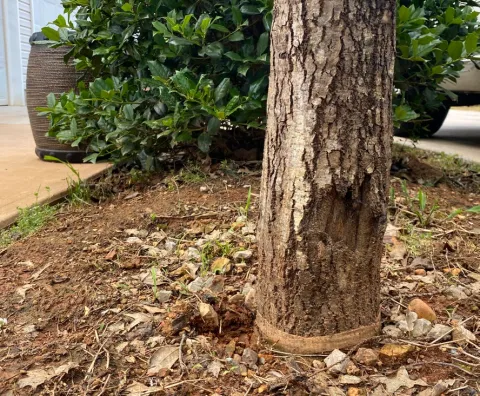Tree Planting Problems

Improper planting depth is one of the most common challenges impacting the growth and health of urban trees. Trees planted incorrectly are not only subjected to the physical stresses of improper placement, they’re also more susceptible to insect pests and fungal pathogens. These issues, combined with the already stressful urban environment, may lead to the untimely decline of trees that would otherwise prosper if planted correctly.
The most common type of improper planting occurs when trees are planted too deeply. When roots are buried too deeply, they lose the ability to exchange oxygen and carbon dioxide and eventually suffocate. The root flare (where the trunk and roots meet), which should normally be dry, is covered in soil and stays moist. This excess moisture makes the trunk more vulnerable to insect pests and fungal pathogens. Altogether, excessively deep planting limits tree lifespan, aesthetics, and can make the tree more hazardous!
Signs of excessive planting depth include girdling roots, branch dieback, premature color change/leaf drop, bark splitting, leaf yellowing, borer insects in the trunk, and epicormics shoots. These symptoms are not exclusive to planting depth but may help your diagnosis. Remember that the surest sign of a tree being planted too deeply is a lack of trunk flare! Trees planted too deep will resemble a telephone pole with little to no flare. Shallow planting is less common and easier to recognize but still a problem for trees in urban areas. Trees planted on steep hillsides and in very tough soils are common candidates for shallow planting. It’s important to remember that most tree roots grow out, not down. If these surface roots do not have access to soil, they may desiccate or begin encircling the trunk. Shallowly planted trees are more vulnerable to root plate failure and reduced growth rates due to decreased root penetration into the surrounding soil. Recognizing shallowly planted trees is relatively easy—simply look for mounded soil directly surrounding the root flare. Soil levels surrounding improperly planted trees may exceed surrounding levels by six inches or more!
Takeaways
Properly planted trees should have an evident root flare, and the surface of the root ball should be level with the surrounding soil on a flat grade. Unfortunately, many trees are sold and shipped with too much soil covering surface roots and trunk flare. When planting, the first large structural roots should be visible before mulch is placed around the tree. Lastly, trees plant
- Log in to post comments